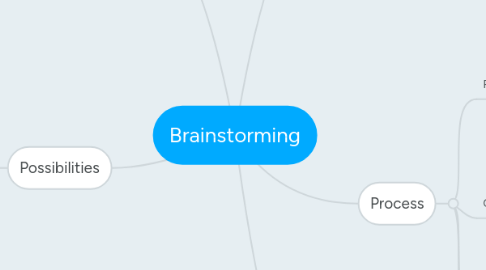
1. Purpose
1.1. Generate lots of ideas
1.2. Involve everyone in a collaborative process
1.3. Foster openness and creativity
1.4. Avoid the common pitfalls of "groupthink"
1.4.1. Desire for consensus
1.4.2. Strong personalities dominate
1.4.3. Praise and criticism of ideas early in the process
1.5. In order to make better decisions
1.5.1. Consider all alternatives
1.5.2. Gather enough information
1.5.3. Group feels ownership
2. Process
2.1. Frame the question or problem
2.1.1. Check for understanding and agreement
2.1.2. Tweak wording if needed
2.1.3. Write it down
2.2. Generate ideas
2.2.1. Structured
2.2.1.1. Passes are OK
2.2.1.2. May cause anxiety
2.2.2. Unstructured
2.2.2.1. Requires active facilitation
2.2.2.2. Less pressure
2.3. Check for proper wording of ideas and record
2.4. Review completed list for clarity
2.5. Move on to organizing results
3. Practice
3.1. What are the challenges facing participants of online classes?
4. Pointers
4.1. Diversity of participants is key
4.2. Manageable groups = 5-7 people
4.3. No feedback, especially criticism
4.4. Wording is important
4.5. Individual brainstorming first
5. Possibilities
5.1. Brainwriting
5.1.1. Encourages thoughtfulness
5.1.2. Different people contribute
5.1.3. Post-its, Google Docs
5.2. Visual
5.2.1. Use diagrams, charts, mind maps, etc.
5.2.2. Draw a picture of the problem
5.3. Free Association
5.3.1. If this problem were an animal, what would it be?
5.4. Rolestorming
5.4.1. Take on specific identities
5.4.2. Reduces inhibitions
5.5. Starbursting
5.5.1. Brainstorm questions
5.5.2. Who is our target audience? What arguments would they find persuasive? What concerns might they have?
5.6. Reverse Brainstorming
5.6.1. What would cause the problem?
5.6.2. What would a bad brainstorming session look like?
5.6.3. How would we discourage teachers from trying out a new technology?
